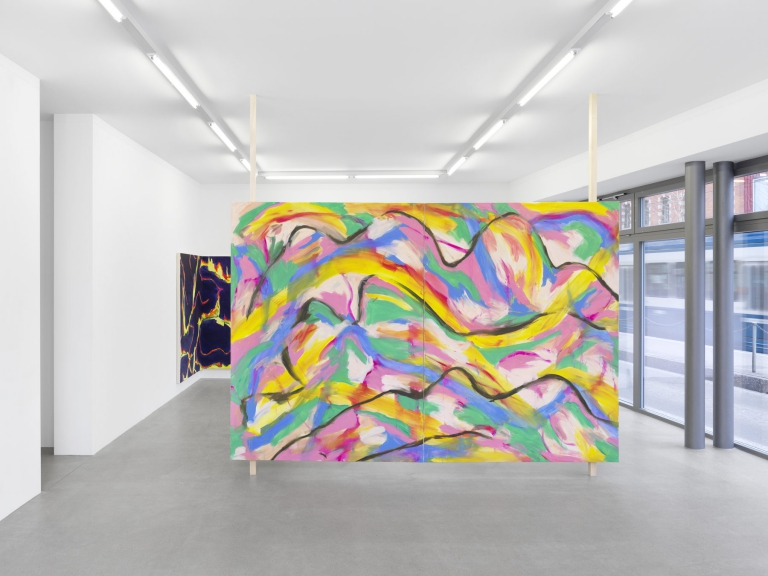Artist: Mathis Gasser
Exhibition title: Breaching
Venue: Weiss Falk, Basel, Switzerland
Date: November 26, 2021 – February 5, 2022
Photography: images copyright and courtesy of the artists and Weiss Falk, Basel
Oskar Weiss and Oliver Falk are delighted to announce Mathis Gasser Breaching, Gasser‘s second solo exhibition at the gallery.
Mathis Gasser’s newest series of paintings prophesies the meeting of giants: images of hulking spaceships mingle with modern museums and surfacing whales, animal and architectural colossi converging at the boundaries of sky, earth, and sea. Each enormous form also acts as a carrier or conveyance of other living things, of artifacts and ideas. Their monumentality recalls the biblical Old Testament sea-monster Leviathan, whose massive scale defies proportion and confounds the mind. The Leviathan symbolizes a vessel for the unknown, appearing either as a revelation of the end of days or threatening to consume the whale that swallows the prophet Jonah. The literary critic Susan Stewart describes the purview of the gigantic Leviathan as “a mixed category, a violator of boundary and rule, an overabundance of the natural and hence an affront to cultural systems… a vast and “natural” creativity that bears within it the capacity for self-destruction.”¹ Like so many Leviathans, Gasser’s ships, structures and whales seem to emerge from the depths of their own environs to breach horizons and break new grounds. Each carries elemental forces to a different surface, foretelling, perhaps, a concerted and cataclysmic rupture.
The gigantic can impose a sense of existential threat when size stands at the threshold of representation. Whether it belongs to the animal, the machine, or the monument, the artist must reduce a big thing’s size and capture its contours on the spectator’s behalf. Human culture has long concerned itself with the pictorial mastery of scale, with harnessing the monumental or even ineffable being or object, and finding its place within nature’s macrocosmic order.
For Gasser, outer space remains a crucial territory of the vast. His paintings of spaceships from Star Trek Discovery derive from a fandom book on the Klingon Fleet (a central alien species within the Star Trek Universe). They show the alien crafts arranged frontally and in profile on a blank surface; the specimen-like rendering of fictional technology evokes the somewhat obsessive love for detail that is common to sci-fi communities. The ships’ minute portrayal disturbs our sense of its grand scale: pictured from two viewpoints against a white background, the tentacular spaceships also take on a creaturely presence that kaleidoscopes down towards the order of insects, bacteria, and other natural specimens that scientific illustrators have faithfully recorded for textbooks and labs.
This biological analogy also corresponds with Gasser’s paintings of different whale species arranged in profile and arranged according to size. However, the ship’s painted versions appear sketch-like compared to the highly detailed imagery of the Star Trek sourcebook. He blurs out some of the ships’ features as if they are seen from afar. Like ghostly silhouettes or blots from a Rorscharch test, we are left to wonder about the ships’ exact nature and scale.
Gasser’s series swiftly descends from the cosmos down to earth. “Breaching” turns to five paintings of newly-built museums and architectural extensions to established art institutions in Switzerland, the UK, and the United States. The buildings and their respective surroundings appear at eye level, from the perspective of passers-by, yet the landscape remains eerily devoid of human presence. These architectural scenes recall the American modernist artist Charles Sheeler’s paintings of cityscapes and industry, which draw on the photographic process to picture buildings as contrasting geometric forms and monochromatic surfaces. Despite photography’s seemingly objective and rational nature, Sheeler’s paintings emanate a mystical presence that transforms their pictured structures into towering spiritual entities. In the same vein, Gasser’s paintings endow the museum exterior with an auratic quality that transforms it from public institution into something arcane. The art historian Mark Rawlinson’s description of Sheeler reverberates within Gasser’s works: “The building’s function or purpose becomes unknowable; its exterior is impenetrable and our relation to it alienated.”² Gasser “alienates” through creative juxtaposition. Like the Klingon vessels, he pictures the art museums from two angles in a manner reminiscent of documentary photography. Our perception of the art museum’s familiar contemporary architecture suddenly shifts when placed next to fictional Klingon spaceships. Like the Klingon vessels, the buildings’ geometric masses invite wonder and curiosity for what is hidden and housed beneath their cavernous interiors. Analogies arise between the museum’s role in conserving artifacts (as forms of cultural heritage) and the Klingons’ Sarcophagus Ship, which is built to store their dead. As though viewed through extraterrestrial eyes, Gasser’s museums seem like mysterious cenotaphs or mausoleums. Analogy allows science fiction’s power of estrangement to spill into the real world. In fact, Gasser’s vision of the social institution as colossal and monstrous predates sci-fi. The seventeenth-century philosopher Thomas Hobbes famously compared society itself to a huge Leviathan: a collective institution that functions as a single organism composed of many distinct parts. The current exhibition explores this idea of institutional unity and the machinations it conceals. The concept of “the breach” has become commonplace in the age of the internet and social media; confidential data is routinely stolen and exchanged. As such, Gasser’s paintings of museums also speak to contemporary institutional debates over questions of provenance, patronage, representation and even repatriation. They reflect a general feeling of mistrust towards the role of institutions in democratic societies.
Yet Gasser’s paintings of alien ships and museums never explicitly yield to a moment of real rupture. The action appears in the series’ final grouping, in which whales surface violently from the ocean’s depths (also known as breaching) and reduce the surrounding fishing boats to smithereens. Gasser directly cites the paintings of the nineteenth-century self-taught British-born artist Charles S. Raleigh, who spent his career in the United States as a seafarer and merchant. His marine paintings include hundreds of whaling ships, some of which explode beneath immense whales that spring out of the water, shattering them into debris and human bodies suspended permanently in mid-air. The surfacing whales tie into older folk tales of sea monsters and even biblical imagery found in the Books of Job and Jonah. Its association with biblical revelation makes it a familiar symbol to Jungian Psychology, where its emergence represents the unconscious depths that dreams reveal. Gasser’s versions of Raleigh’s paintings never show the giant whale’s entirety – just parts rising from the sea’s surface. This partial concealment adds to the fascination and terror of the subliminal and the sub-marine.
From the Star Trek fanbase to Raleigh’s American folk art, Gasser continues to demonstrate a keen interest in imagery from past and present popular realms: the Klingon ships point to future-oriented imagination, the museum renders the contemporary moment, and Raleigh’s pictures conjure the past. Descending from space to the horizon, the series forces us to the surface of the deep and the hidden forces that could always spring forth at any time, in any time, and swallow our fragile vessels.
-Samuel Luterbacher
¹ Susan Stewart, On Longing (Durham: Duke University press), 73
² Mark Rawlinson: Charles Sheeler, Modernism, Precisionism and the Borders of Abstraction (Routeledge: New York), 75
Mathis Gasser, Breaching, 2021, exhibition view, Weiss Falk, Basel
Mathis Gasser, Breaching, 2021, exhibition view, Weiss Falk, Basel
Mathis Gasser, Breaching, 2021, exhibition view, Weiss Falk, Basel
Mathis Gasser, Breaching, 2021, exhibition view, Weiss Falk, Basel
Mathis Gasser, Breaching, 2021, exhibition view, Weiss Falk, Basel
Mathis Gasser, Breaching, 2021, exhibition view, Weiss Falk, Basel
Mathis Gasser, Breaching, 2021, exhibition view, Weiss Falk, Basel
Mathis Gasser, Breaching, 2021, exhibition view, Weiss Falk, Basel
Mathis Gasser, Breaching, 2021, exhibition view, Weiss Falk, Basel
Mathis Gasser, Breaching, 2021, exhibition view, Weiss Falk, Basel
Mathis Gasser, Breaching, 2021, exhibition view, Weiss Falk, Basel
Mathis Gasser, Breaching, 2021, exhibition view, Weiss Falk, Basel
Mathis Gasser, Breaching, 2021, exhibition view, Weiss Falk, Basel
Mathis Gasser, Breaching, 2021, exhibition view, Weiss Falk, Basel
Mathis Gasser, Breaching, 2021, exhibition view, Weiss Falk, Basel
Mathis Gasser, Kunstmuseum Basel, 2021, Oil on canvas, 145 × 100 cm
Mathis Gasser, MCBA Lausanne, 2021, Oil on canvas, 145 × 100 cm
Mathis Gasser, Schaulager, Basel, 2021, Oil on canvas, 145 × 100 cm
Mathis Gasser, NMAAHC, Washington, 2021, Oil on canvas, 145 × 95 cm
Mathis Gasser, The Hepworth Wakefield, 2021, Oil on canvas, 145 × 95 cm
Mathis Gasser, Veqlargh Class, 2021, Oil on canvas, 145 × 95 cm
Mathis Gasser, Qoj Class, 2021, Oil on canvas, 145 × 95 cm
Mathis Gasser, Sarcophagus, 2021, Oil on canvas, 145 × 100 cm
Mathis Gasser, Qugh Class, 2021, Oil on canvas, 145 × 100 cm
Mathis Gasser, Qaw Class, 2021, Oil on canvas, 145 × 105 cm
Mathis Gasser, Chargh Class, 2021, Oil on canvas, 145 × 115 cm
Mathis Gasser, Jach Class, 2021, Oil on canvas, 145 × 115 cm
Mathis Gasser, Klingon Ship Chart, 2021, Oil on canvas, 180 × 125 cm
Mathis Gasser, Bortas Bir Class, 2021, Oil on canvas, 145 × 115 cm
Mathis Gasser, Whalers I (After Charles S. Raleigh), 2021, Oil on canvas, 30 × 44 cm
Mathis Gasser, Whalers II (After Charles S. Raleigh), 2021, Oil on canvas, 30 × 44 cm
Mathis Gasser, Whalers III (After Charles S. Raleigh), 2021, Oil on canvas, 30 × 44 cm
Mathis Gasser, Nine Whales, 2021, Oil on canvas, 180 × 130 cm







































